Nowadays there’s a lot of discussion about lossless and lossy audio files – and which is better.
Unfortunately there are a lot of misconceptions about both lossless and lossy formats, which is why it is best to start by understanding more about each of them.
So, without further ado, lets check out the basic difference between Loosless and Lossy audio files below.
“What Are Lossless Audio Files?”
When audio is first recorded it is uncompressed and is normally in a format such as PCM, WAV or AIFF. Unfortunately such files are very large, which is why they need to be compressed to make them easier to manage.

Lossless audio files are essentially audio files that use a lossless compression – meaning the raw audio is compressed without any data being discarded. As a result you can technically restore the raw audio from the lossless audio file.
While that may seem great – before you jump to any conclusion you should know more about lossy audio files.
“What Are Lossy Audio Files?”
Unlike lossless audio files, lossy audio files use lossy compression – meaning that some data that is deemed ‘unnecessary’ is discarded when it is compressed. Although that may not sound ideal, it allows lossy audio files to be much smaller than their lossless counterparts.
Additionally while technically the quality of lossy audio files may not be as good – whether or not you are able to hear the difference is another question entirely. If the audio is listened to on standard computer speakers, or even normal earphones, odds are the difference in quality will be minimal.
In short, it is a tradeoff. On one hand you end up with a much smaller sized audio file that is easier to store and transfer, but on the other hand the quality will be lower.
“Which is Better?”
The big question at the end of the day is: Which is better – lossless audio files or lossy audio files? And the answer to that each is good in different situations.
If you have limited storage space such as on mobile devices or audio players, lossy audio files are definitely preferable. Normally you won’t be able to tell the difference via the regular earphones, and the difference in file size will mean that you can store more music to listen to.
To permanently store a music collection however it is better to use lossless audio files, as you can preserve them in the best possible quality and then convert them to lossy formats as required. That versatility isn’t present in lossy formats, and for example if you convert MP3 to WAV using Convertio, the quality will remain identical to that of the original MP3.
At the end of the day now that you understand the difference between lossy and lossless audio files, it should make it easier for you to decide which one is best based on how you intend to use it. If you have any doubts about whether the quality of lossless audio is worthwhile, you could always listen to samples of lossless and lossy audio on your speakers or earphones to see if you can tell the difference.




